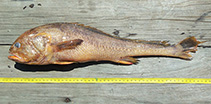| Family: |
Sciaenidae (Drums or croakers) |
| Max. size: |
50 cm SL (male/unsexed) |
| Environment: |
benthopelagic; brackish; marine |
| Distribution: |
Western Central Pacific: Viet Nam, Thailand and Borneo. |
| Diagnosis: |
Dorsal spines (total): 6-7; Dorsal soft rays (total): 42-44; Anal spines: 2-2; Anal soft rays: 7-8; Vertebrae: 12-25. Elongate, cylindrical body. Eye small, 14-24 % of head length. Mental pores in 2 pairs, the first small, rounded, at front of chin, separated by symphysis. Gill rakers long, slender, equal to or slightly longer than gill filaments at angle of arch, 12-14 on lower limb. Dorsal fin with VI to VII spines and 42-44 soft rays, not incised between the two parts. Second anal spine long, stiff, 37-46 % of head length; the last dorsal, second anal, pectoral and pelvic spines progressively thicker with age or size. Scales cycloid (smooth) on head, ctenoid (rough to touch) on body. Swim bladder carrot-shaped, with 1 pair of tube-like appendages arising at the anterior end and immediately dividing into an anterior branch entering the head and ramifying under skull and a posterior tube lying beside the main bladder to its posterior end. |
| Biology: |
Inhabits shallow coastal waters and estuaries (Ref. 9772). |
| IUCN Red List Status: |
Data deficient (DD); Date assessed: 27 September 2018 Ref. (130435)
|
| Threat to humans: |
harmless |
Source and more info: www.fishbase.org. For personal, classroom, and other internal use only. Not for publication.

